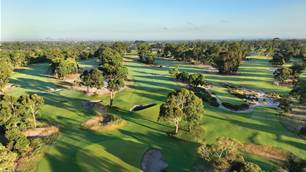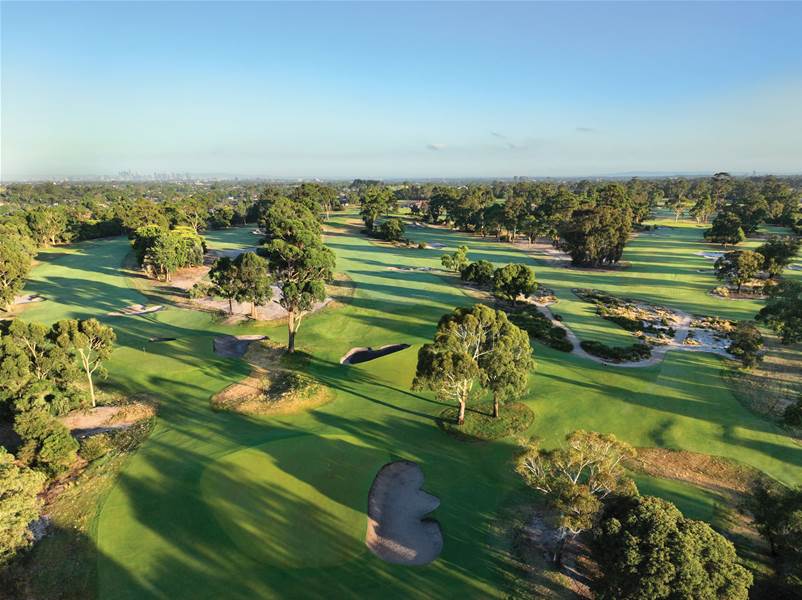Brian Slawnik and Tom Doak of Renaissance Golf Design have long been unabashed fans of the Sandbelt, and of Commonwealth Golf Club in particular. When asked to redesign the course, the first thing Slawnik told members was that it’s already great and that RGD would approach the work as preservationists. What Slawnik, RGD and Commonwealth greens staff did since has reimagined and reinvigorated one of Australia’s great courses.
Following a trip to Australia in 1988, Tom Doak returned home to write a book he would call The Confidential Guide to Golf Courses. It was meant as a guide for his friends, so often had the well-travelled, 26-year-old, enfant terrible of golf course design been asked about the best places to play in various countries. He self-published 40 copies, presented them as gifts, and, presumably, thought relatively little more about it.
This would change, of course. Because, of course, the book did not remain confidential. Indeed, it became a sensation. For as Doak’s reputation for course design grew along with his business, so too did the potency of his no longer confidential guide. Such was demand he printed another thousand copies. He took it to a publisher who printed another 12,000. When that limited edition sold out and the internet took off, people were selling copies on Ebay for up to $US800. The Wall Street Journal wrote a story about it.
The secret was in Doak’s honesty. He had written the book for his friends, and had thus been unflinching in his appraisal of courses he believed were over-rated, had weird design characteristics, or were simply bad. One layout in Pinehurst was “so dull” it made him “want to spit”. Several high-profile Australian courses were not spared Doak’s critique, either, even if his more searing sentiments were toned down in subsequent volumes.
Of course, it wasn’t only a hatchet job. The man was mentored by Pete Dye and counts Dr Alister MacKenzie as a muse. Anyone lucky enough to play Tara Iti will know the man has a wonderful eye. And thus, the book included hidden gems, master works and a list of 31 courses he “would take a good friend to see”.
Commonwealth Golf Club was one of them.
“The genius of Commonwealth is its adherence to one simple rule - that each green should be oriented or tilted in such a way that it cradles an approach from one side of the fairway and shoulders away shots from the incorrect line of approach,” Doak wrote.

Doak later told protégé and business partner, Brian Slawnik, that “Commonwealth is a puzzle that’s perfectly put together”.
A quarter century later, Doak and Slawnik returned to Commonwealth when their design company, Renaissance Golf Design (RGD), was contracted for the course’s own renaissance. Slawnik tells Golf Australia magazine that the first time he saw Commonwealth was in the early ‘90s when RGD was building Cape Kidnappers in New Zealand.
“I made a stop through and toured around the Sandbelt and it definitely left an impression,” Slawnik says. “I remember it being a favourite of Tom’s from some of his writings from back in the day. It was certainly on our radar, and certainly we saw it as an opportunity when they called.”
But he did feel a weight of responsibility.
“Having already done a lot of work on the Sandbelt, I felt pretty comfortable that I had a reasonable handle on how build to the style,” Slawnik says. Then he smiles and adds: “Not that self-doubt and I don’t have a deep and abiding relationship!
“But one thing was clear: the members love it. And they had loved it before we touched it, so that was an important thing to always keep in mind. One of the first things I told them in my first report was, ‘You’ve got a great golf course now. If you don’t do anything you’re way ahead of most golf courses worldwide. And I’m not in the business of messing up golf courses’.
“So, it was more about preservation than anything. It wasn’t a situation of having our way with it. It was more respecting what was good and fixing what wasn’t quite working.”

While the members loved the course, they were smart and humble enough to recognise that they needed some help. They needed direction.
“They had made changes over the years and made some mistakes, and it like we were almost brought in for counselling,” Slawnik says.
RGD’s master plan involved changing all 18 green complexes, though “the only greens we did significant changes to, really, were the ones that had already been redone,” Slawnik says. “So it was about trying to get them back.”
The greens would be re-grassed with Pure Distinction bentgrass, the surrounds would be Santa Ana couch. Slawnik says the grass choice was “a club decision.”
“We certainly weigh in on grassing, if asked, but we tend to defer to the guy that’s growing it in. And if the superintendent wants it one way doesn’t think option B is going to work, option B is probably not going to work,” Slawnik says.
“One of the things I liked about [the choice of Pure Distinction], and it’s run through all the work we’ve done on the Sandbelt, is that it’s about finding points of difference between the clubs and highlighting them so they feel like their own, they have their own character.”

Like its near-neighbours Metropolitan and Yarra Yarra, and the world-renowned Royal Melbourne and Kingston Heath, and others in this concentration of malleable loam made of sand, silt and clay, the greenside bunkering at Commonwealth is part of its wow-factor. It’s like they’re cut from glass, shaped by giant sushi knives. There’s something surgical about the hard-cuts against the edges. Slawnik says it’s “something that’s very unique to the Sandbelt”.
“There’s so many great things about the area, not the least of which is that you’ve got this collection of great golf courses that all really do have their own character, even though they’re somewhat unified by the soil types, the grass types, and the way wind blows.
“Each of them over a hundred years of play has evolved and there’s this very specific style of bunkering which has that razor edge, that deep layer and lip,” Slawnik says.
“Having worked at Royal, having worked on the Mornington Peninsula, having worked at Yarra Yara, Woodlands, I’ve had a lot of experience with figuring out how to recreate that look and accelerate the ageing process, if you will.
“But it’s all about the soil. It’s all about that that beautiful grey sand that just holds the shape and the grass types, too, are a key component. Michael Clayton said jokingly years ago, the bunkers in the Sandbelt are so great because they don’t have sand in them.”
Harley Kruse and Paul Mogford had earlier been tasked with cleaning up “issues created by poor planting of non-native and native trees in decades past,” former Golf Australia magazine editor, Brendan James, writes in his book Great Golf Courses Australia.
“An extensive tree planting program during the 1990s ultimately saw playing lines narrowed and in some places turf quality suffered, but the decision to undertake a program of opening the course up by clearing away unnecessary trees and shrubs has certainly had a positive impact. It is far more complementary with the vision of its various designers, and is what impressed Doak the most,” according to James.
Removing the trees has meant removing shade and competition for moisture. It’s reduced water usage and improved the health of the turf. For play, it’s opened up sightlines and increased shot options and strategy. It’s all “cleaner” and visually more appealing. It just looks better.
To celebrate the work, Commonwealth invited Slawnik back to the club for a function. He says he doesn’t like playing the courses he redesigns – “purely a function of the quality of my game right now,” he jokes – but he does enjoy play on his creations.
“I’m certainly happy with it, but more importantly it seems to have been pretty well received by the membership, which is all that really matters,” Slawnik says.
“These sorts of jobs are always fun because as the work is happening, other parts of the golf course are open so we’re constantly watching people play golf and seeing all the different swings and all the different wild shots people create, accidentally or otherwise.
“It all informs the work.”

Commonwealth Course Manager, Adam Lamb, says that the new greens, and clearing out so much extraneous scrub and trees, has meant greater “playability” – call it “fun” - for the members.
Lamb is no stranger to the Sandbelt, having completed his apprenticeship at Metropolitan under the current Royal Melbourne Superintendent, Richard Forsyth. He is also a handy golfer who hovers around scratch and has played Pennant golf for Woodlands where he remains a member.
Says Lamb of the more ‘open’ look to Commonwealth: “It’s not easier - the path to ‘par’ remains a test. Players still have to find the right angles into flags. And there are some new angles into greens.
“And remodelling those greens has made it a true test of Sandbelt golf and unlocked a new experience. With new and firmer greens, and some new pin positions, it’s made it challenging, fun, and tournament quality.
“The members are very complimentary. They’re enjoying the new experience.”
FACT FILE - COMMONWEALTH GOLF CLUB
LOCATION: Glennie Avenue, South Oakleigh, Victoria
CONTACT: (03) 9575 0444
WEB: www.commonwealthgolf.com.au
DESIGNERS: Sam Bennett (1921), Charles H. Lane (1926), Sloan Morpeth (1962), Kevin Hartley (1992), OCCM: Geoff Ogilvy, Mike Clayton, Mike Cocking, Ashley Mead (2006-19); Renaissance Golf Design: Tom Doak, Brian Slawnik (2021 and ongoing)
PLAYING SURFACES: Legend couch (fairways), Pure Distinction bentgrass
(greens), Santa Ana couch (green surrounds)
PGA PROFESSIONALS: Lachlan Kenny, Director of Golf; Marcus Hakkinen, Head Teaching Professional.
COURSE MANAGER: Adam Lamb.
Related Articles

Top-100 Spotlight: Commonwealth Golf Club

Course Review: Cape Kidnappers













